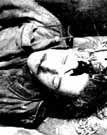
|
|
|

|

|

|

|
|
Click on an image to see a larger, more detailed picture.
|
|
|
|
|
| 1942: The "Final Solution" |

|
pg. 356 |

|
|
|
|
| |
 Jasenovac, the largest of the Croatian concentration and death camps, was established in autumn 1941. It became the final destination for some several hundred thousand Gypsies, Serbs, and Jews. As this man's battered and broken skull shows, the camp, run by the Ustasa, was especially barbaric. Thousands were murdered outright or simply starved to death as a result of the inhuman conditions. In 1942 some 12,000 Jewish and Serbian children were executed.
Jasenovac, the largest of the Croatian concentration and death camps, was established in autumn 1941. It became the final destination for some several hundred thousand Gypsies, Serbs, and Jews. As this man's battered and broken skull shows, the camp, run by the Ustasa, was especially barbaric. Thousands were murdered outright or simply starved to death as a result of the inhuman conditions. In 1942 some 12,000 Jewish and Serbian children were executed.
Photo: Yad Vashem
|
 Founded in the 1920s, the Zionist organization he-Halutz (The Pioneer) taught young German and Austrian Jews the essentials of farming. After the Nazis gained power, the organization accelerated its training efforts. Once members qualified for labor permits as skilled farmers, they could obtain permission to join the fortunate few legally permitted to enter Palestine.
Founded in the 1920s, the Zionist organization he-Halutz (The Pioneer) taught young German and Austrian Jews the essentials of farming. After the Nazis gained power, the organization accelerated its training efforts. Once members qualified for labor permits as skilled farmers, they could obtain permission to join the fortunate few legally permitted to enter Palestine.
Photo: Beth Hatefutsoth
|
 Breendonck
Breendonck
The concentration camp at Breendonck, Belgium, was a primary internment point for Jews in Occupied Belgium. Located about 15 miles south of Antwerp, it was a moated fortress that dated from the early 1900s. The Nazis turned Breendonck into a place of internment in the summer of 1940, adding cells, gallows, barracks, a torture chamber, a site to drown prisoners and another to bury them alive, and quarters for the camp's SS and Wehrmacht overseers. The prisoners' food and living conditions were execrable, and extreme physical cruelty was encouraged by the camp's head of forced labor, Artur Prauss. On September 24, 1942, Rabbi Dr. Salomon Ullman--chief Jewish chaplain of the Belgian military since 1937--was sent to Breendonck as a warning to resisters. Ullman was released after 15 days; other Jewish detainees were not as fortunate. When deportations of Jews from Belgium began in 1942, many Jewish prisoners held at Breendonck were sent to the Jewish transit camp at Mechelen before being condemned to Auschwitz. Breendonck's Belgian location and the harshness of its administrators "distinguish" it; Jews were never held there in great numbers, but all who were suffered terribly. Between 1940 and 1944 the number of Jewish prisoners never exceeded 200, and by 1942 Jews no longer comprised the majority of inmates. The camp was liberated in the summer of 1944.
Photo: Center for Historical Research and Documentation on War
|
|

|

|

|

|
 August 25-26, 1942: Thousands of Jews from Miedzyrzec, Poland, are deported to the Treblinka death camp.
August 25-26, 1942: Thousands of Jews from Miedzyrzec, Poland, are deported to the Treblinka death camp.
|
 August 25-26, 1942: Nearly 1000 Belgian Jews, including 232 children, are deported to the East.
August 25-26, 1942: Nearly 1000 Belgian Jews, including 232 children, are deported to the East.
|
 August 26, 1942: 518 Jewish children deported from Paris are gassed at Auschwitz.
August 26, 1942: 518 Jewish children deported from Paris are gassed at Auschwitz.
|
 August 27, 1942: Eight thousand Jews from Wieliczka, Poland, are killed at the Belzec death camp.
August 27, 1942: Eight thousand Jews from Wieliczka, Poland, are killed at the Belzec death camp.
|
 August 27, 1942: When a transport train carrying 6000 Jews from Miedzyrzec, Poland, arrives at the Treblinka extermination camp, guards discover that nearly all of 6000 have died of suffocation during the 75-mile journey.
August 27, 1942: When a transport train carrying 6000 Jews from Miedzyrzec, Poland, arrives at the Treblinka extermination camp, guards discover that nearly all of 6000 have died of suffocation during the 75-mile journey.
|
|
|
|
|
| 1942: The "Final Solution" |

|
pg. 356 |

|
|
The Holocaust Chronicle
© 2009 Publications International, Ltd.
|
|
